Entering mid-March, Real Sociedad were the hottest team in La Liga.
Three months off the pitch haven’t benefitted La Real as they’ve secured just one point against Osasuna and Deportivo Alavés.
Imanol Alguacil’s side has dropped out of the UEFA Champions League spot, and they are in a battle to secure any form of European play.
Meanwhile, Zinedine Zidane’s men have earned two comfortable victories, scoring three goals in each match.
Marco Asensio returned from nearly a year away from the pitch to record a goal and assist against Valencia.
Furthermore, Hazard has been a revelation in these past two matches.
This tactical analysis will preview La Liga’s top two Reals matchup.
In addition to predicting the lineup and result, we’ll examine the reasons for Real Sociedad’s slow start and pinpoint areas of improvement for the match against Real Madrid.
For Los Blancos, we’ll examine how they’ll look at the attacking shape and areas of attacking emphasis and discuss how they plan to unbalance Real Sociedad.
Real Sociedad Vs Real Madrid Preview: Probable Starting Lineups
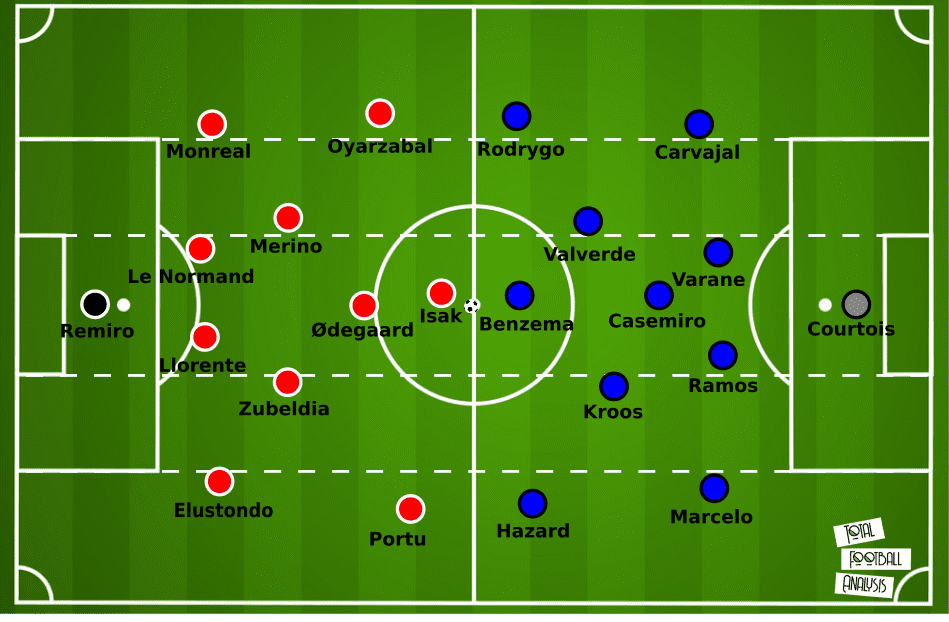
Real Sociedad (4-2-3-1): Álex Remiro; Aritz Elustondo, Diego Llorente, Robin Le Normand, Nacho Monreal; Mikel Merino, Igor Zubeldia; Martin Ødegaard, Portu, Mikel Oyarzabal; Alexander Isak.
Injuries are mounting for Real Sociedad, with Martin Ødegaard joining the list of doubtful players.
I’m keeping him in the lineup because he’s a sure starter if he can recover in time for the match.
If he’s unable to go, look for La Real to move to a 4-4-2 for the match with Willian José or Portu starting next to Isak.
If Portu starts at forward, Adnan Januzaj will likely start on the right.
Real Madrid (4-3-3): Thibaut Courtois; Dani Carvajal, Raphael Varane, Sergio Ramos, Marcelo; Casemiro, Toni Kroos, Federico Valverde; Eden Hazard, Rodrygo, Karim Benzema.
Does Hazard start for a third consecutive match? That’s the big question.
Given this is the toughest side remaining on the fixture list, I’d imagine he has to start.
Vinícius Júnior and Luka Modrić are outsiders in this one but are possibilities.
At the very least, you should see them come on as substitutes.
While Carvajal should be set to play again, Éder Militão, starting at right-back, is one of my dark horse candidates for the starting lineup.
Given Real Sociedad’s emphasis on central domination, the right-back will likely play more conservatively anyway, accounting for Oyarzabal.
Again, I suspect Carvajal, though fatigued, will start, but Militão at right-back wouldn’t shock me either.
Finally, if he’s fit, Marcelo offers a nice attacking upside play in this one.
Real Sociedad Preview: Aiming to Reverse a Poor Restart
Real Sociedad has enjoyed a lot of possession in the past two matches, averaging roughly 63.5% per game.
Still, the quality of play, especially among the attackers, is well below their pre-COVID-19 form.
After a low xG showing against Osasuna (1.16 xG), the side put on a horrendous display against Deportivo Alavés, losing the match 2-0.
In terms of xG, Alavés recorded 2.54 xG to 0.63 for Sociedad.
That gives an indication of the disparity in the number and quality of shots.
For the match, La Real took eight shots, only one of which hit the target, whereas Osasuna recorded 14 shots, seven on the frame.
What ails Real Sociedad?
For a side that looks to draw opponents high up the pitch, break lines, and make runs behind the lines from overloaded starting points, rhythm is critical, especially in syncing the progressive runs and passes.
When studying Real Sociedad’s style of play on film, fluidity in attack is lacking, and their understanding of how to play off of each other needs polishing.
Below is a still frame of Los Txuri-urdin’s attacking shape in the recent match against Osasuna.
As the team secures possession and starts to build out, the #6 will drop in between his two centre-backs while the two outside-backs push higher up the pitch, in line with the box-to-box midfielder.
Meanwhile, the striker and three attacking midfielders occupy the central channel and half-spaces.
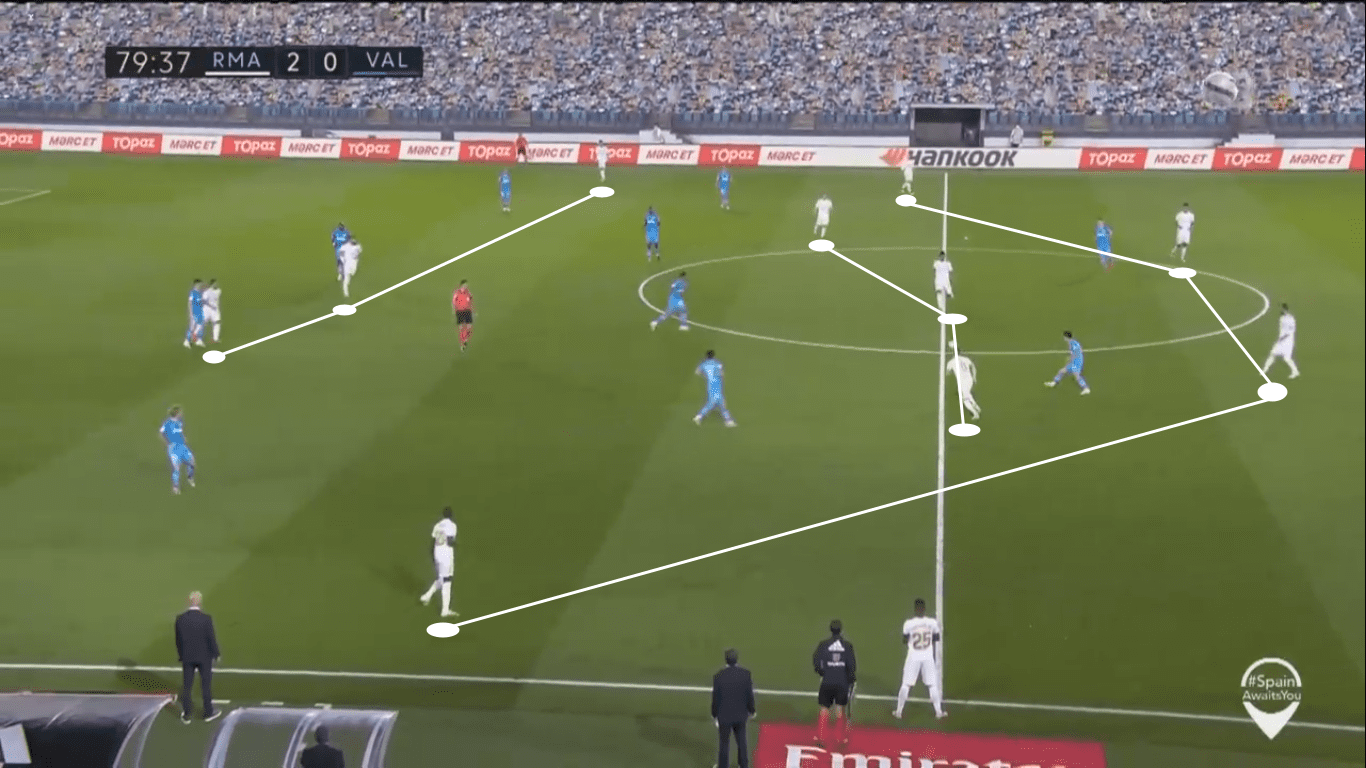
The benefit of the central overload is that it frees the wings for the outside-backs.
Occupying the backline, possibly the holding midfielder as well, is that the defence must become very narrow to negate the more immediate threat of central penetration.
When the ball finally arrives on the wings, the backline is forced to move out of its very compact shape to offer resistance on the wing.
As this happens, gaps emerge.
When Real Sociedad is at its best, it plays through the gaps, forcing the opposition into a recovery defence.
Few teams do this well, especially with so many high runners to track, allowing Sociedad to make their move to goal.
In this match, they must show improvement at the top of the formation.
Given that they like to move the four highest players centrally, using the outside backs for width, Sociedad’s ability to play the high targets and get them to work off each other more effectively is key.
If Ødegaard is healthy, expect Real
Sociedad’s tactics to emphasize the right side of the pitch, pinning or at least limiting the left-back’s attacks.
As the club climbed up the table leading into the break, these situations and half-space deliveries were succeeding.
They’ve struggled in this area since the break.
In the example below, as José checks to the ball, the defender goes with him.
Portu sees the opportunity to run behind the defence, but the ball never arrives.
Rather than playing into the gap, La Real opted to play a sequence of short passes, failing to break the resistance.
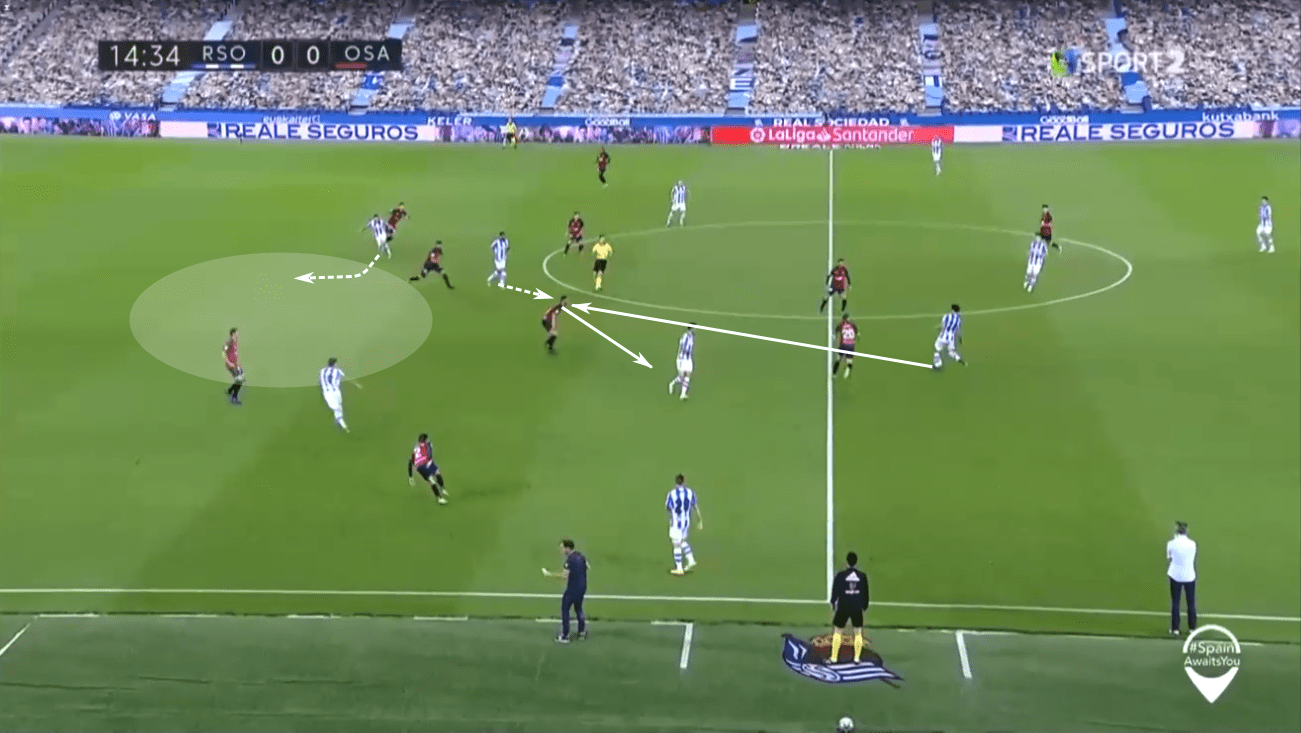
The San Sebastián team must show more creativity and cutting-edge tactics as they engage the backline for success against this Real Madrid side.
The central overload allows the attackers to play off of each other, using quick combination play to get behind the backline.
Again, from the match against Osasuna, Real Sociedad played over the midfield and into the forwards.
The first ball was won and set back to a teammate.
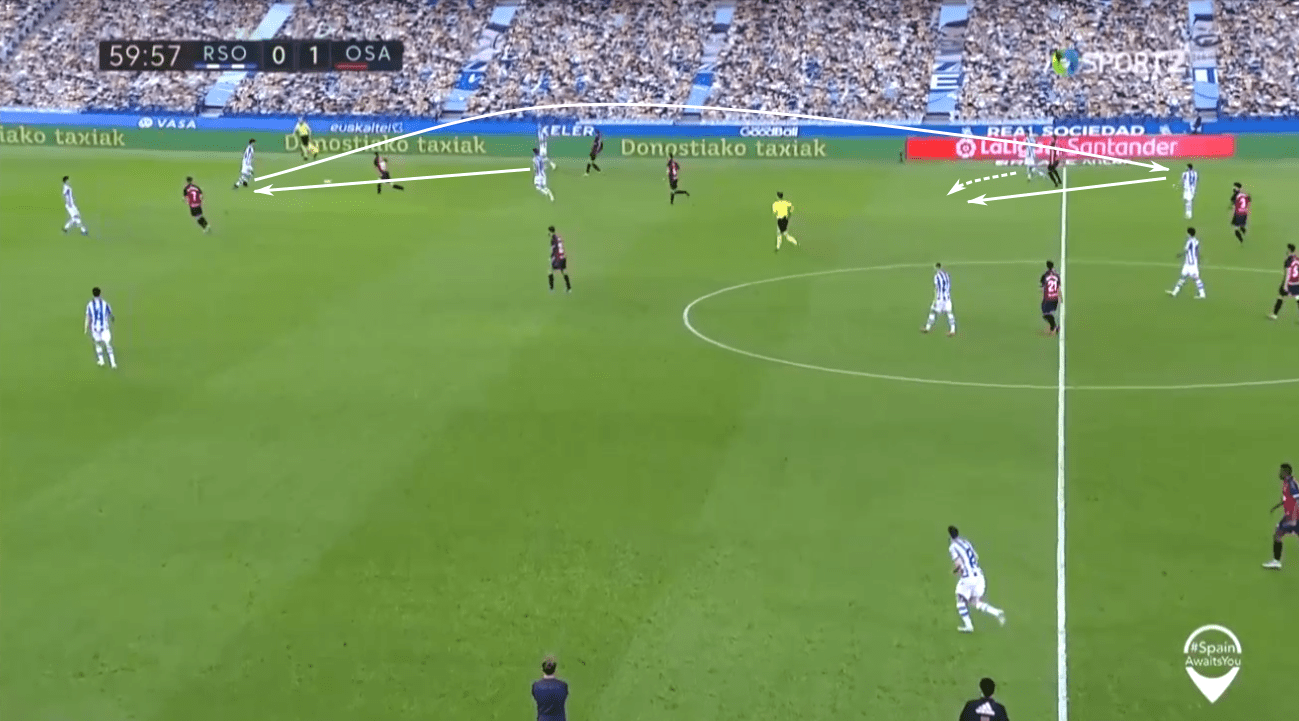
With the ball set back and the defence unbalanced, the two highest players made vertical runs, opening up a central dribbling lane for their José.
He dribbled deep into the Osasuna half, playing a lateral pass to Oyarzabal for the equaliser.
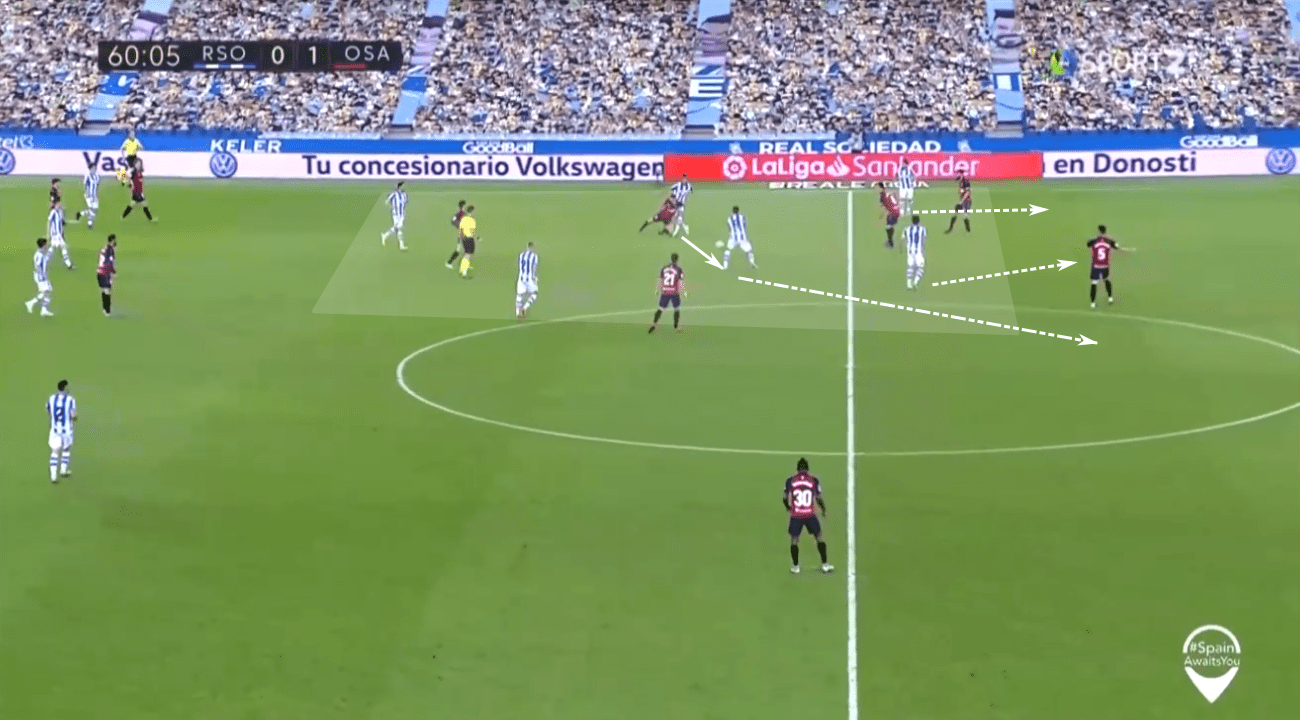
The side is most dangerous in situations like these.
With numeric equality in the shaded area, Real Sociedad were able to use their qualitative advantage and sharp movements off the ball to disorganise the opposition.
Real Madrid Preview: Trying To Extend an impressive attacking streak
Though we’re yet to see a complete performance from Real Madrid, the first two matches back have featured a 3-0 halftime lead and an excellent second-half response against Valencia.
In fact, in that Valencia match, Madrid didn’t allow a single shot in the second half and managed to score three of their own.
Hazard’s return has certainly sparked some exciting attacking football.
Additionally, he brings out the best in Benzema.
One thing we’re seeing is that these two are situated close to each other.
Benzema stays closer to the centre of the pitch while Hazard drifts between the central channel and half-space.
The Belgian will typically position himself close to Benzema, which carries the added benefit of preventing the Frenchman from dropping too deep or wide to connect with teammates.
Look for them to command the attention of Llorente and Le Normand.
If the direct pass is on, Los Merengues will play it, but the Hazard/Benzema pairing also frees up the wings for 1v1 duels.
With Real Sociedad playing so narrowly, Marcelo should enjoy a relatively free role with plenty of freedom to attack.
Like this example against Valencia, the side’s width is provided by the left-back and right-forward.
Carvajal’s positioning and participation in the attacking third have been more conservative.
In the midfield, Kroos and Casemiro continue to operate as the primary distributors, while the right-centre midfielder starts higher up the pitch, typically connected to the right forward.

If Marcelo starts, expect him to take full advantage of Real Madrid’s style of play.
If Hazard is able to start a third match in eight days, expect Marcelo to roam the wings before cutting inside as he approaches the Sociedad box.
Should Vinícius Júnior start, watch for Marcelo frequently directing his runs into the half-space, as he did in the example below against Barcelona.
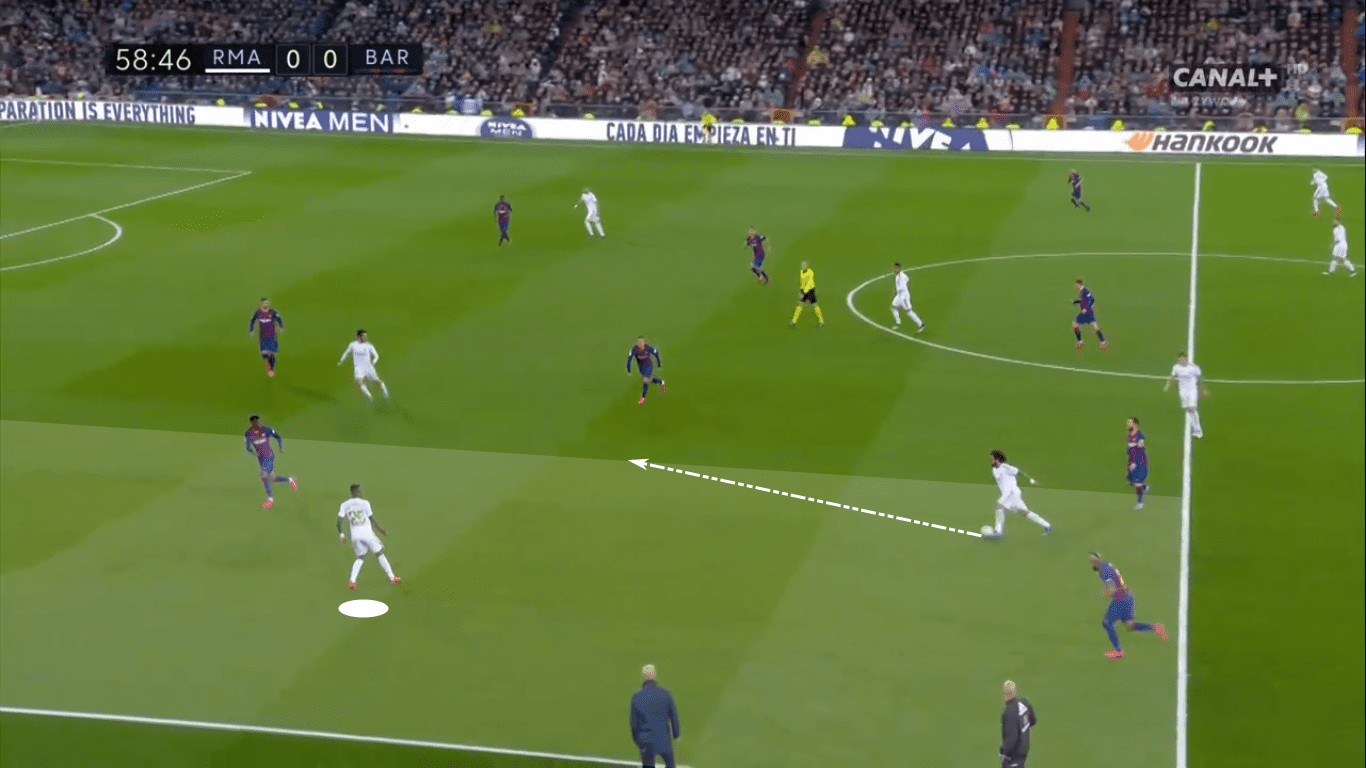
One reason I decided on images from El Clásico is the similarities between Real Sociedad’s and Barcelona’s tactics.
Both teams play at a high tempo, drawing opponents out and using zonal overloads to progress.
They’re similar defensively, too, with each side pressing high up the pitch and looking to pin opponents in disadvantageous positions.
One of the vulnerabilities is a defensive imbalance that allows opponents to play out of the press.
In the latest Clásico, we saw Barcelona applying high pressure on Real Madrid’s right wing.
They were unable to win the ball, and Los Merengues played back to Varane.
The French centre-back hit a beautiful, first-time pass into Marcelo’s path, directing the Brazilian into the space in front of him.
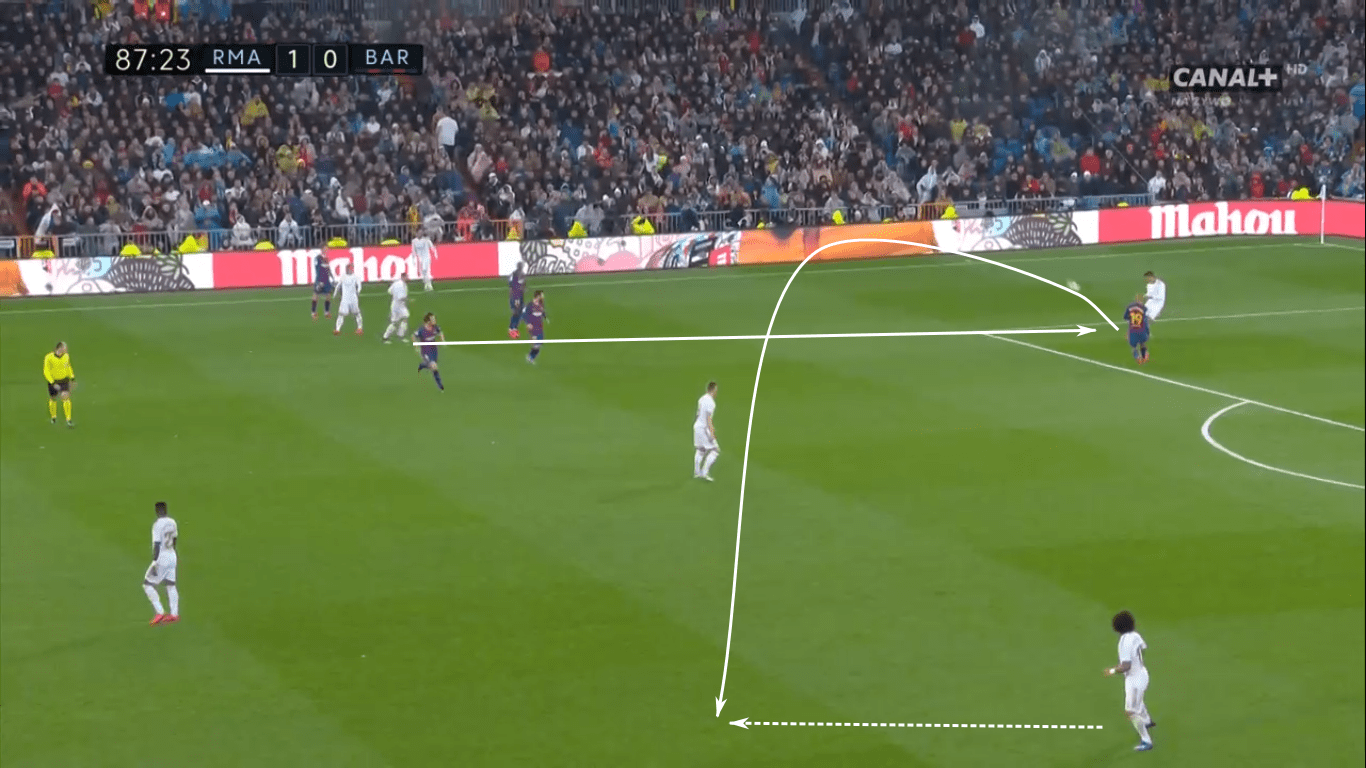
With Barcelona committing so many numbers to the other side of the pitch in a high press, he had nothing but green in front of him.
As he dribbled forward, Benzema and Vinícius Júnior made runs behind the defence.
Marcelo slipped Big Benz behind the line, then took his place centrally.
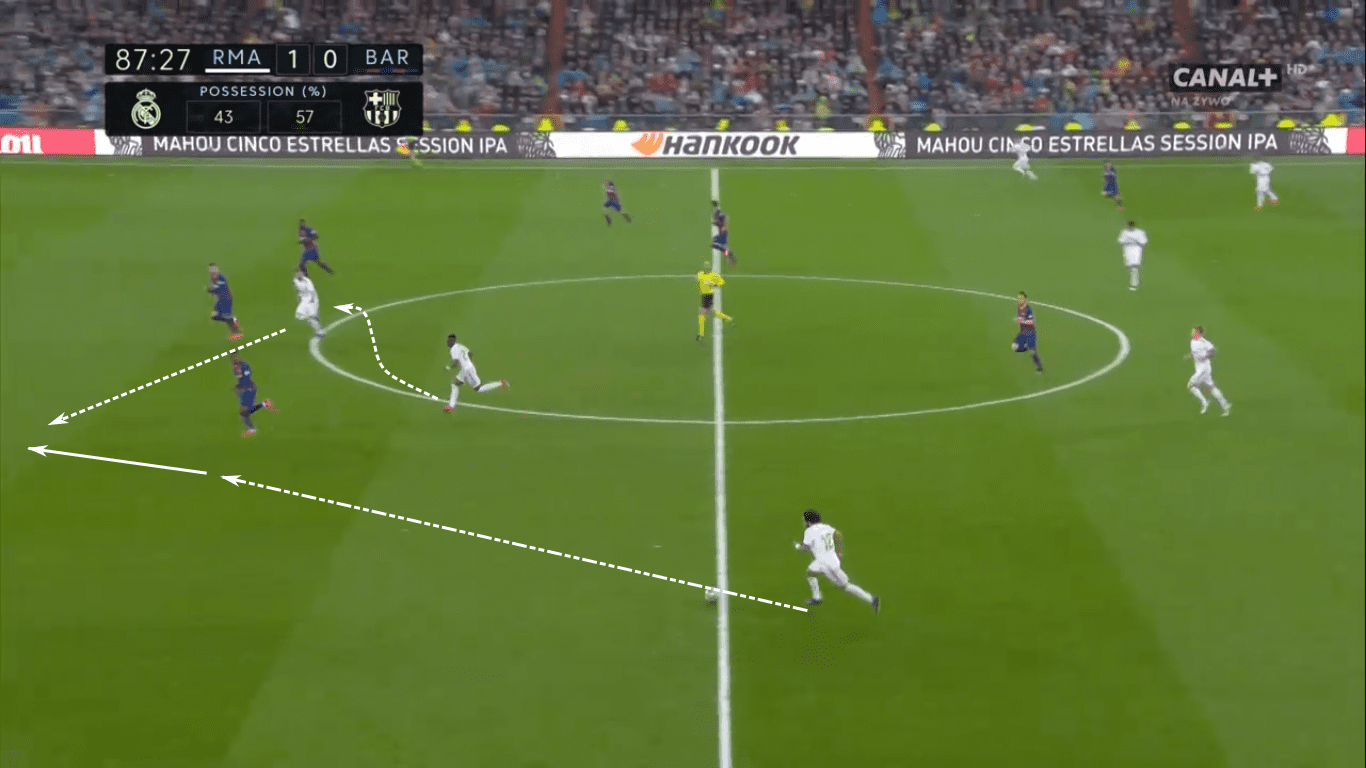
As Benzema approached the box, Vinícius Júnior and Marcelo coordinated their runs into the box, driving Barcelona’s defenders towards goal.
Without a clear passing lane to his two highest teammates, Benzema set the ball back to his oncoming midfielders.
You can see Kroos with his arms extended, begging for the set.
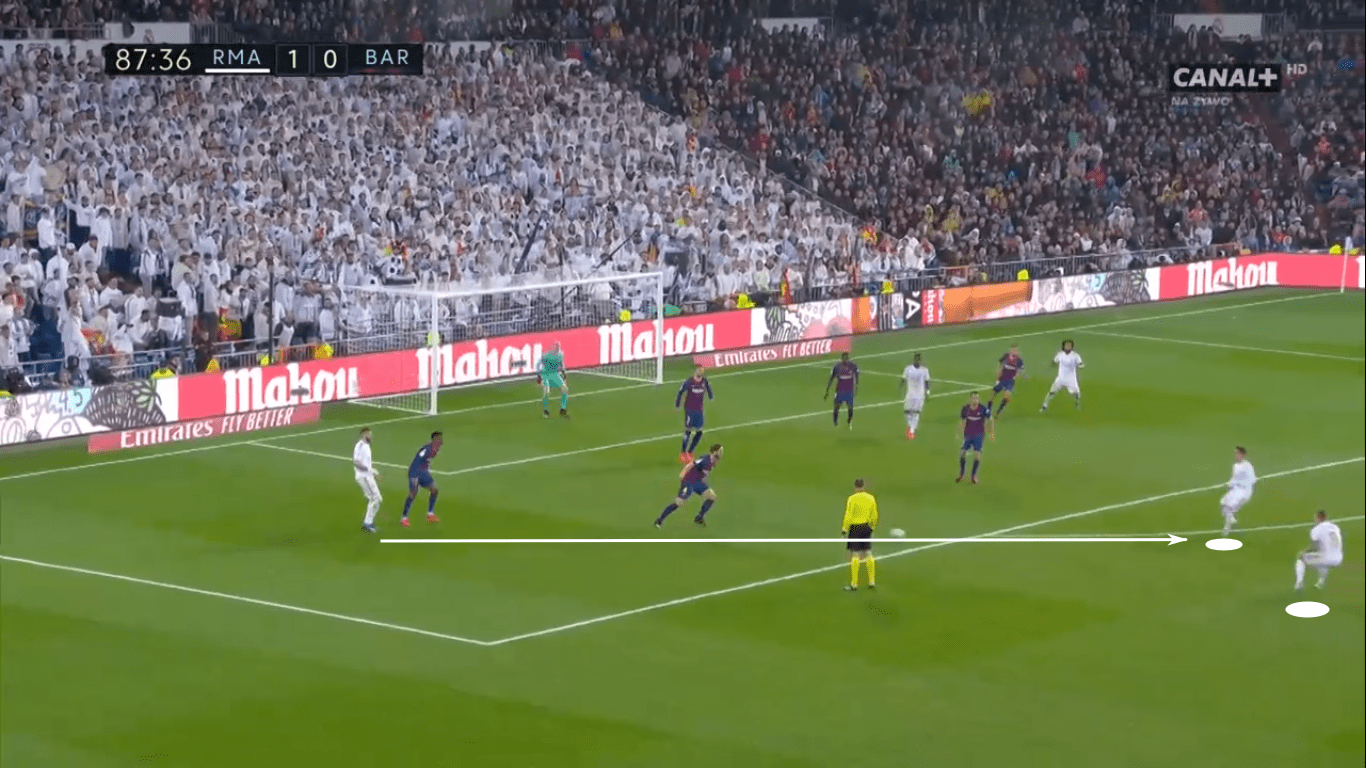
Madrid should have more of the ball in this match, though not by much.
Rather than sitting deep as they did in the Copa del Rey, I expect Sociedad to have between 45-48% of possession.
If they do come out looking to claim a near-equal share of the ball, look for Real Madrid to attack them with quick transitions.
Real Sociedad Vs Real Madrid Preview: Keys To The Matchup
For Real Sociedad, the ability to break the Madrid high press will be key to their attacking success.
The Basque Country squad likes to pull opponents high up the pitch to play line-breaking passes then.
Vertical imbalance is the first objective when the side attacks.
As the opponent overcommits high up the pitch, a line-breaking pass to an overloaded area secures progression.
It situates the players close to each other, resulting in a combination of play that unbalances the opposition’s backline vertically and horizontally.
Swift attacking moves up the pitch following that prolonged build-out, nearly always through well-hit ground passes that enable a quick tempo.
For Real Madrid, the attacking initiative is on them.
They face an opponent that prefers to press high up the pitch and has one of the best PPDA’s in La Liga, recording an impressive mark of 8.82.
If Los Merengues can break that intense pressure, they will effectively let La Real unbalance themselves.
Deportivo Alavés recently showed that clubs can take advantage of Real Sociedad’s disorganised high press.
In the image below, Alavés has drawn Txuri-urdinak high up the pitch to press.
The attacking midfielders’ line has moved too high, and the defensive midfielders’ position is too far to one side.
That opens up massive areas, highlighted in blue, for Alavés to attack.
Regardless of Real Madrid’s starters at outside-back, expect them to offer outlets in the wings.
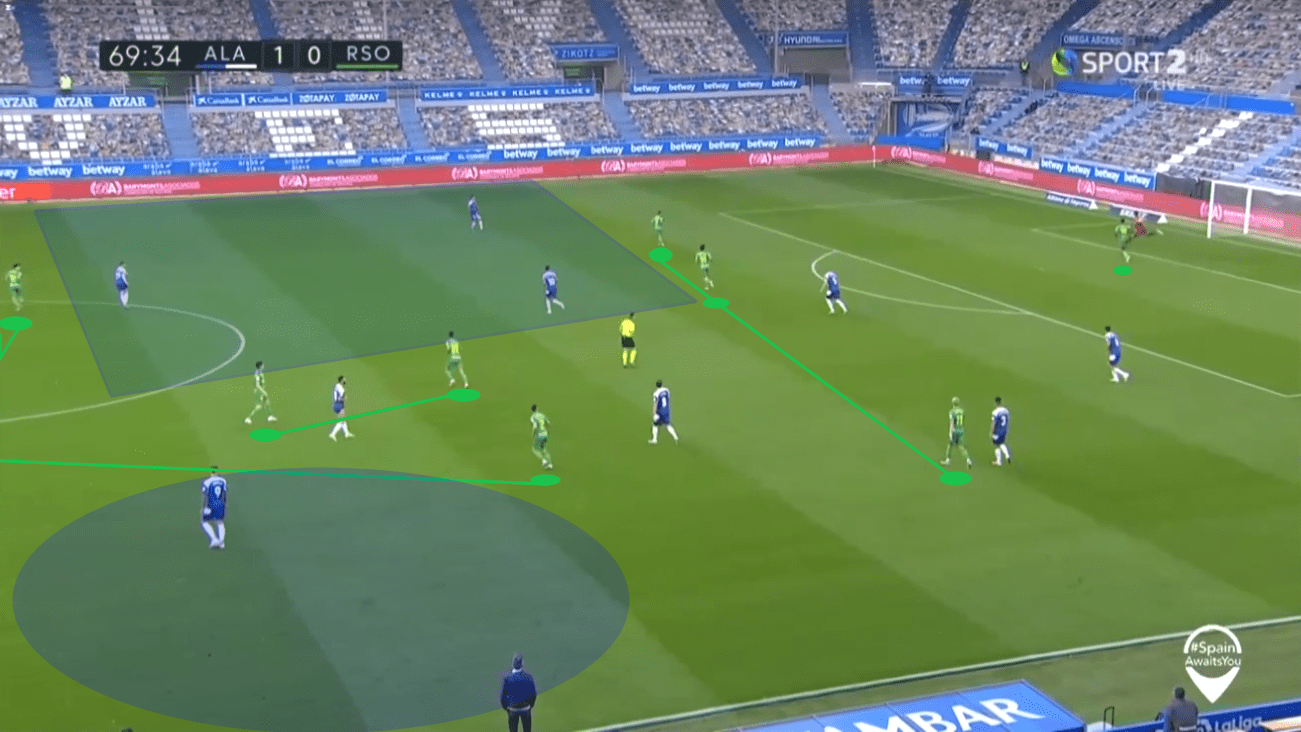
La Real hurry back to pressure the ball carrier, but not before Alavés slips the wide midfielder past the defence.
Even if Alavés hadn’t played that pass, they were 3v2 in that area.
A pass into the half-space was also available, showing how poorly positioned the defence was.
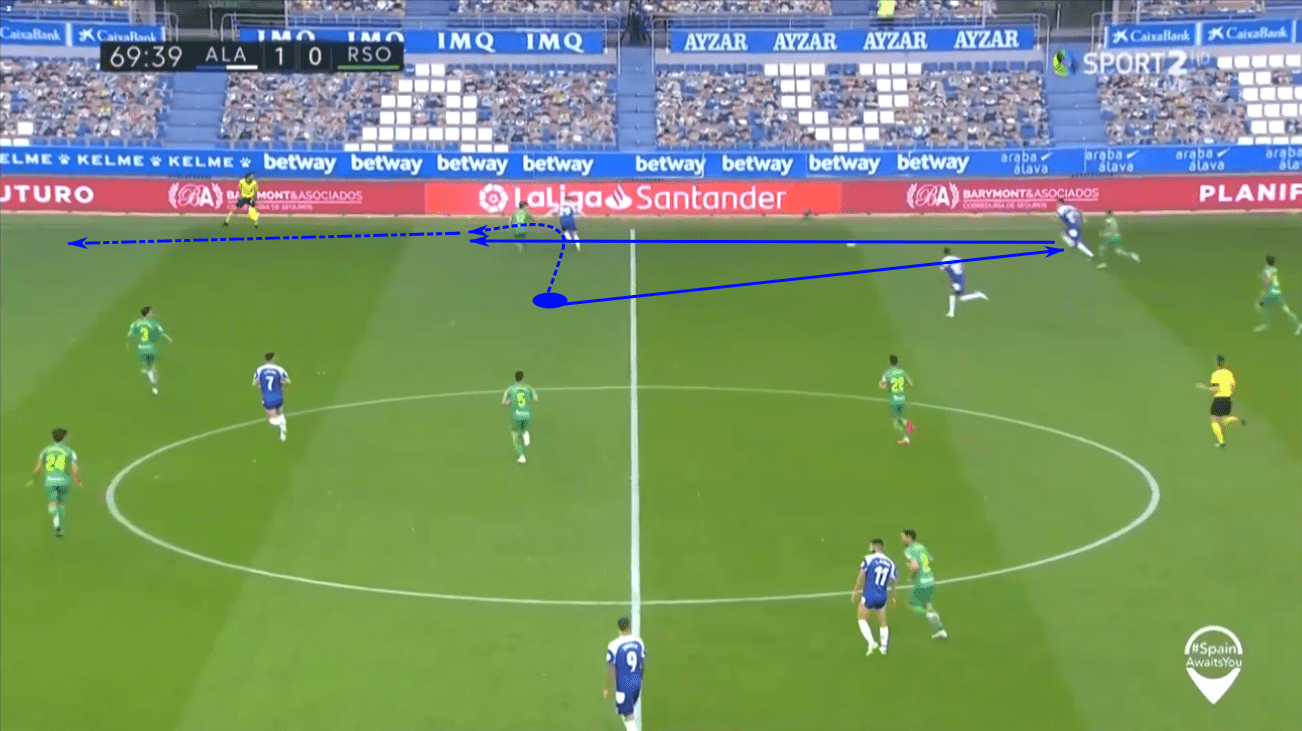
As Alavés progressed into the box, the defenders retreated to the six while the midfielders ball-watched while protecting the top of the box.
Finding a gap between the lines, Lucas Pérez halted his run.
Borja Sainz played the square pass, which the forward smashed against the post.
Moments later, Luis Rioja, number 11 at the bottom of the image, received the ball with no one near him.
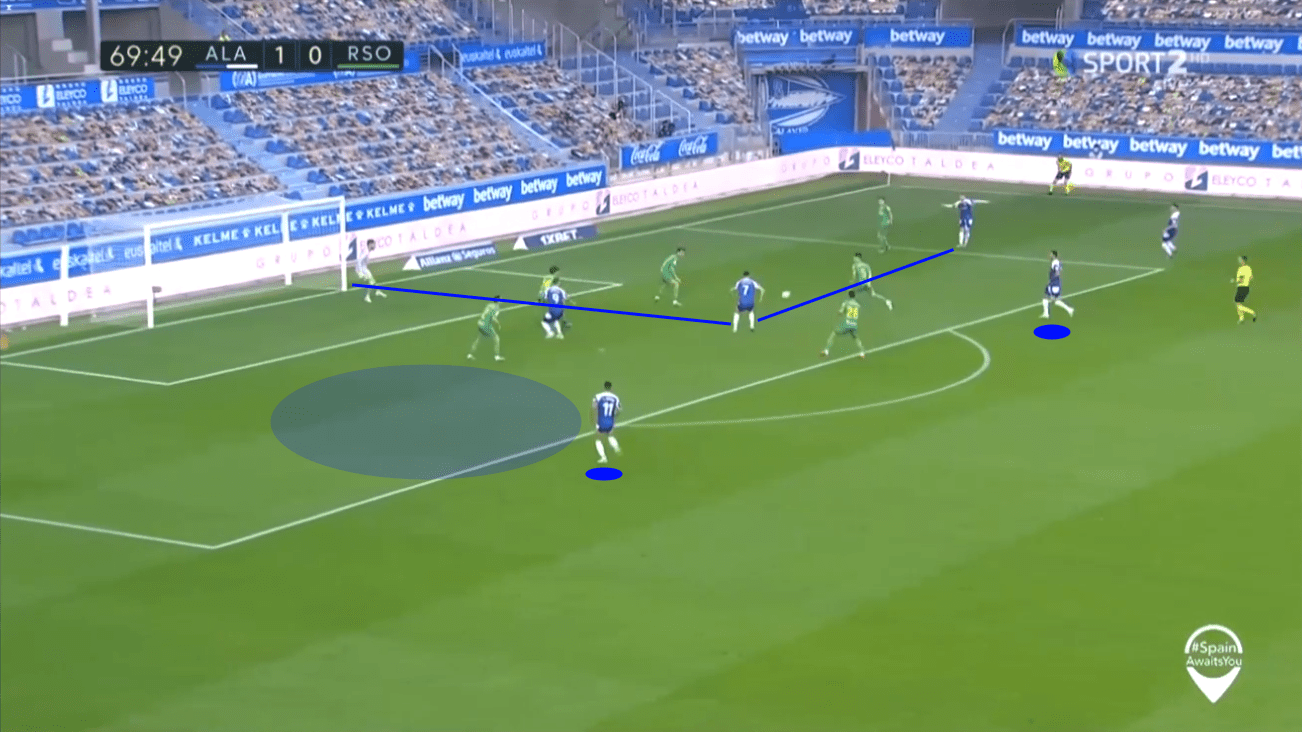
Though Alavés didn’t score, they revealed some cracks in the Sociedad defence.
A side like Real Madrid excels in similar situations.
Their ability to unbalance opponents and make quick moves to goal is the strength of the side.
With 33.57 penalty area entries per match, compared to 20.32 for their opponents, Real Madrid’s quick moves to goal present an issue for Sociedad.
Los Blancos scored three goals in the two matches against La Real.
In terms of shots, Madrid had 18 to 11 and 21 to 10 advantages this season.
In the 4-3 Copa del Rey win, Isak’s individual heroics secured the victory.
Real Sociedad will have to keep a close eye on their rest defence to get a result.
When they do break lines, it’s common to see them burst forward with extraordinary pace.
That’s reasonable against most teams.
With the opposition drawing high up the pitch, there is typically lots of space to attack and a qualitative advantage in their favour.
Against Real Madrid, they’ll have to deal with Casemiro, Ramos and Varane.
Not only are they excellent tacklers, but each can restart Los Merengues’ counterattack.
As we saw against Valencia, a full-throttle attack can quickly end in a counterattack going the other direction.
Below, Ramos has just made a brilliant tackle, knocking the ball forward to Hazard in the process.
Since Los Murciélagos were caught sprinting forward, the Belgian left-winger had room to dribble forward alone in space.
As he dribbled, Benzema and Modrić made their own runs.
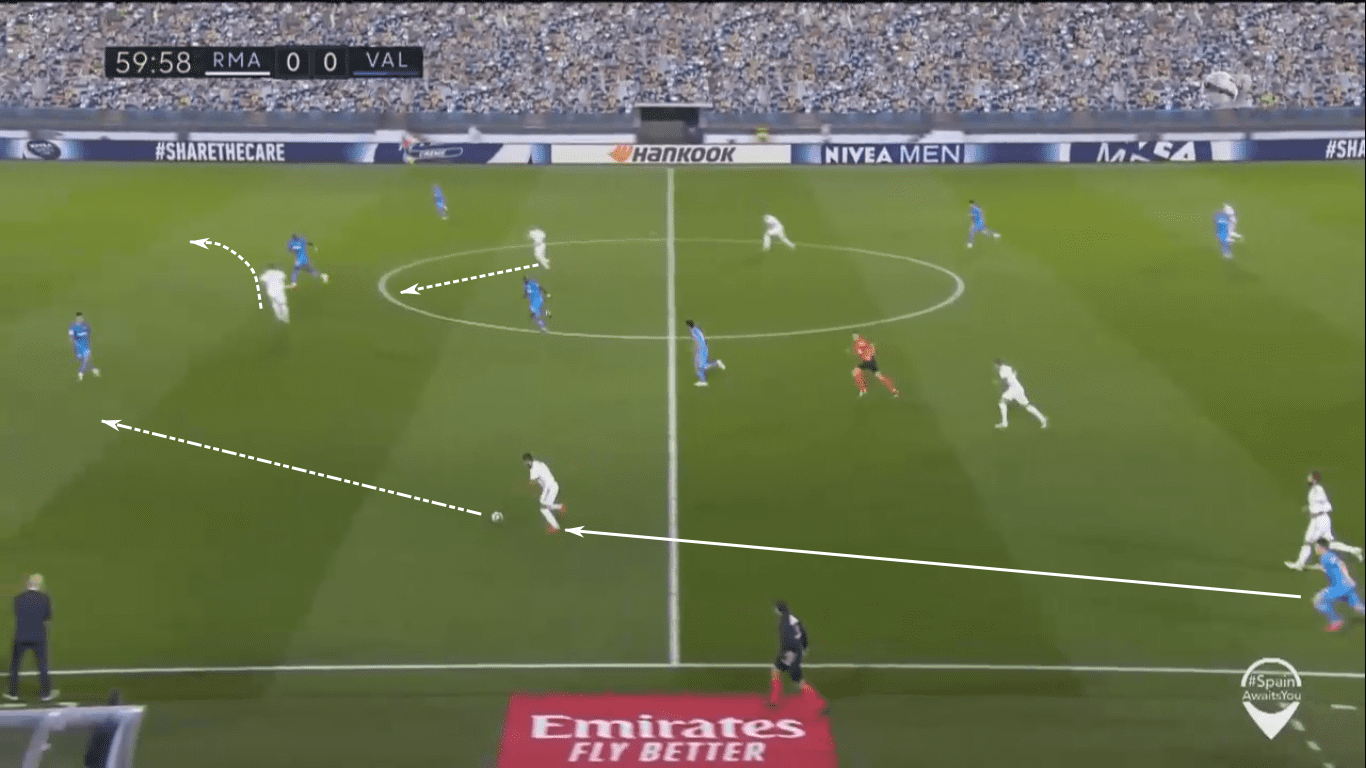
As Hazard meets the opposition, he pins them before swinging the ball to Modrić.
With the Valencia defenders poorly positioned to run with him, Eden Hazard progressed into the highlighted area.
Just outside that area, Karim Benzema keeps his direct opponent from offering defensive cover.
Benzema´s off-the-shoulder positioning forces the defender to stay with him.
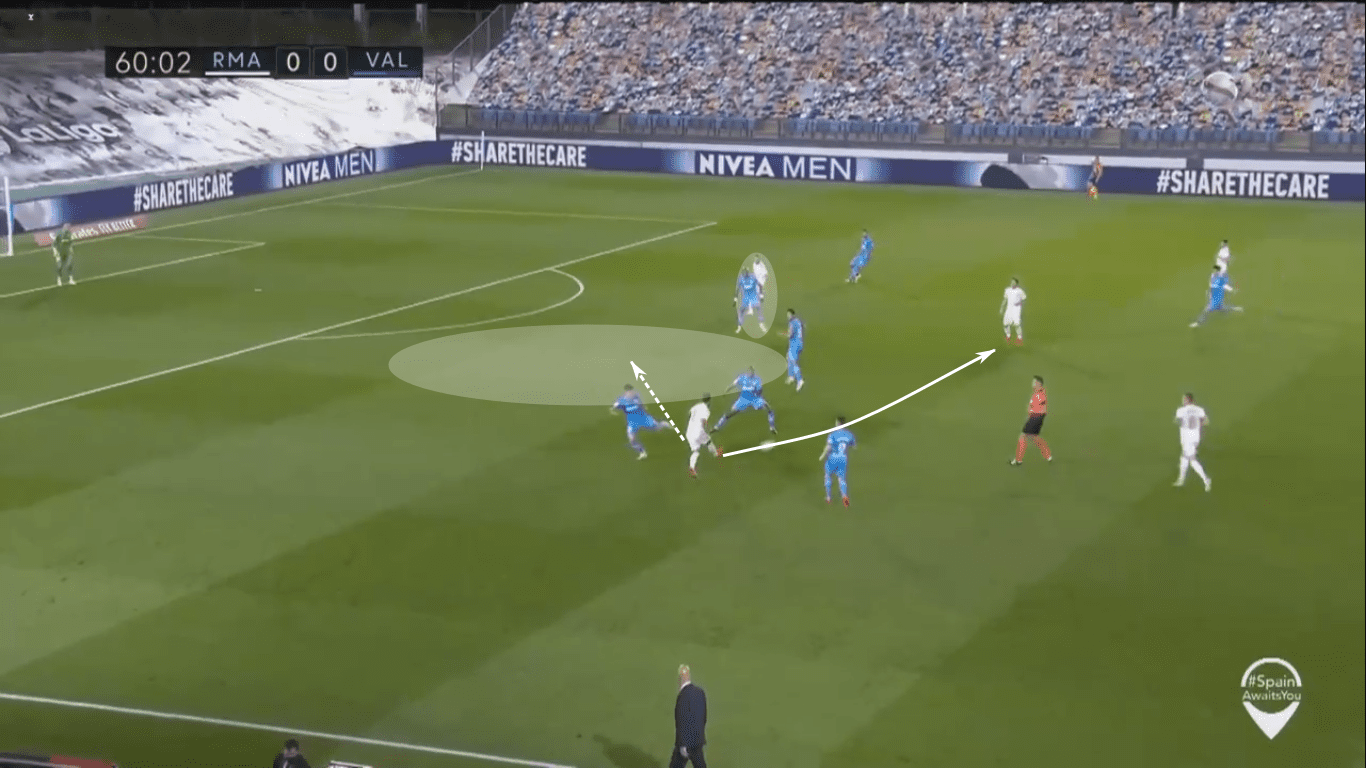
The give-and-go between Eden Hazard and Luka Modrić worked perfectly.
As the combination took place, Benzema moved even wider, creating more separation from the defender and a diagonal path to the goal.
His decision-making is very clever, as he ensures that his approach will see his momentum directed towards the goal rather than away from it.
Slick passing set up the game-winner.
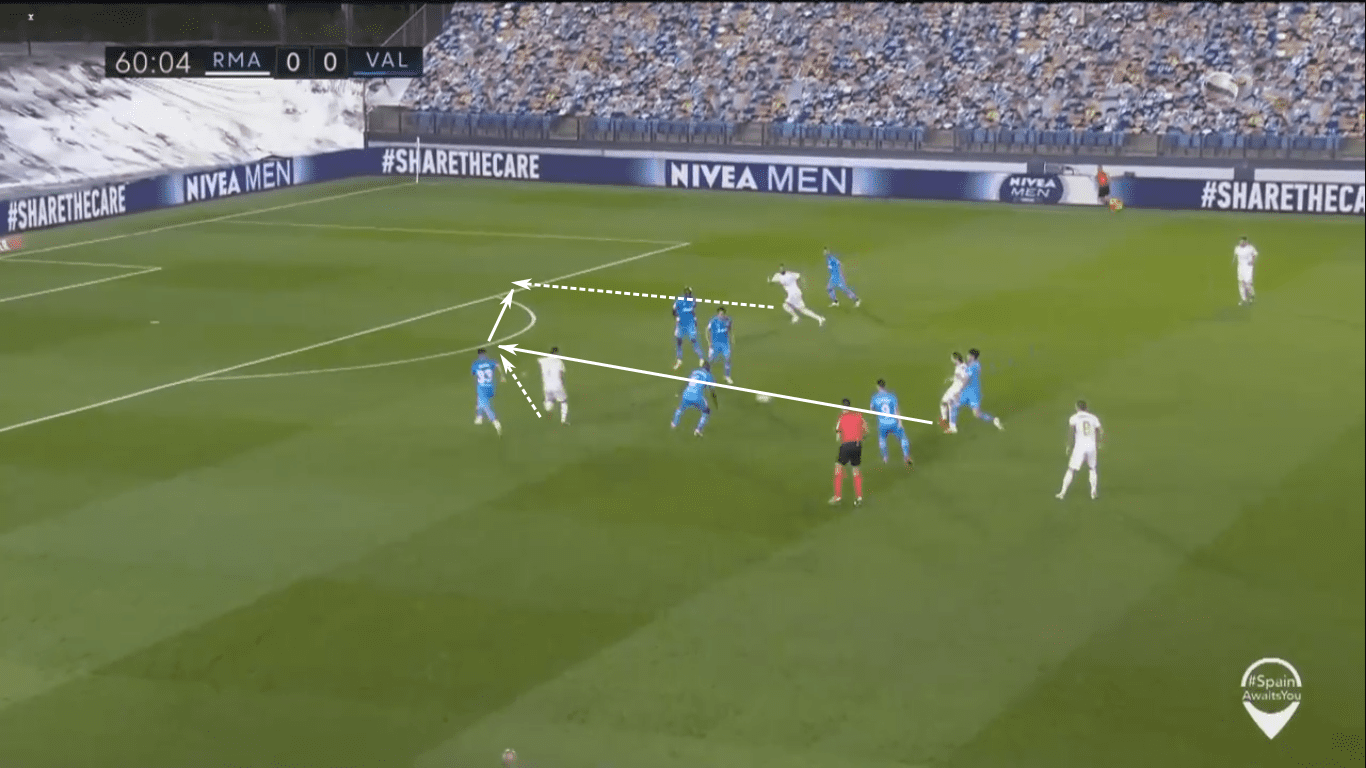
If the Belgian winger does start, Sociedad’s right side of the pitch could be an issue, especially with Joseba Zaldúa suspended for the match.
That’s La Real’s critical defensive zone to watch as the match unfolds.
Conclusion
While this should be a tightly contested match, Real Sociedad’s stumble out of the gates, accompanied by Real Madrid’s hot start, is problematic.
Entering the COVID-19 suspension of play, the Basque Country side was playing the best football in La Liga.
As this analysis has drawn out, the break has thrown them off their rhythm, which has seen them drop outside of the UEFA Champions League spots.
Meanwhile, Los Merengues has yet to put in a full 90 minutes of top-class football since returning to the pitch, but they’ve absolutely looked dominant for one half in each match.
Given the congested fixture list, just enough will be good enough, especially for a side that can rotate without much of a drop in talent on the pitch.
Though Los Blancos should have more high-quality chances, I suspect the scoreline will remain close.
Look for a 2-1 victory for Real Madrid.





Comments